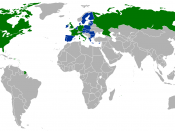Table of contentsINTRODUCTIONSECTION 1: THE BELGIAN FRAMEWORK UNTIL THE 1970SSECTION 2: A DEEP EVOLUTION SINCE THE 1970SCONCLUSIONBIBLIOGRAPHYIntroductionBelgium is an international country, especially through its commitment in the European Union (EU).
Thus, the country has made evolved its accounting legislation to adapt it to the international needs.
However, we can observe two different stages: before the 1970s and after this period.
These two parts constitute the body of our report. We will study in the first one the main influences that explain the initial position.
In our second paragraph we will see that the causes of change are mainly external to the country. However, the past influences remain: we will see how it still has an impact on the current framework.
Section1The Belgian framework until the 1970s1. Setting the sceneIn 1873 a Company Law is established in Belgium that stated on the issue of stocks, the statutes of the companies and the disclosure of annuals accounts (Alexander, 1992).
Even if it has been amended several times, until the 1970s it remains deeply influenced by the French system, especially by the Napoleonic Commercial Code of 1807 (Blake, 1993).
This legislation is characterised by the low level of disclosure required: balance sheet and income statement are mandatory but there is no obligation for further disclosure.
What is more, the Belgian balance sheets were known as "pocket-size" ones : only six items had to be disclosed in it in order to meet the requirements (Alexander, 1992).
The only requirement for the income statement was to present a "true and fair" depreciation.
In the same spirit, the law provided limited disclosure of the investment in kind because of the fear of overvaluation in the intangible assets (De Rongé, 1993).
Isolated initiatives from the biggest companies of further disclosure exist but they are not standardized...
![Alexander Muir Public School, Toronto, 1902 [OHQ-PICTURES-S-R-599]](https://s.writework.com/uploads/9/95250/alexander-muir-public-school-toronto-1902-ohq-pictures-s-r-5-thumb.jpg)

